#longobard
Text
Trying to understand the political strategies and subterfuges between Longobards, Byzantines and Saracens is like trying to solve a math equation when all you can do is 2+2
1 note
·
View note
Text



Amidst rugged hills, a ghost village stands frozen in time. Its abandoned homes, once vibrant with life, now bear witness to nature's reclamation. Collapsed roofs and unhinged doors frame a poignant tale of desertion. Within these stones, echoes of Longobard settlers and Norman conquerors whisper through history's layers. The steps that once connected lives now crumble, as trees and grass break through walls.
What uncertain fate awaits this relic? Will the village's secrets endure, or vanish like the residents who departed in the 1970s? As we contemplate its enigmatic past, we're left to wonder—will time's embrace be its ultimate salvation or demise?
Source: https://jeroentaal.photography/series/villaggio-silenzioso/
663 notes
·
View notes
Text
The Langobards

The Langobards/Lombards/Longobards are an Italic-Germanic tribe with origins in southern Scandinavia around the first centuries B.C. and A.D.
Their steady migration southward can be retraced by archaeological artifacts, which show their Scandinavian origin.
Their early connections to (the geographical city of) Rome made them very influential in the Western Roman world; on financial, military, religious but also law practice and kingship levels.
The Lombards were quickly christened and were the founding fathers of many religious institutions in northern Italy, ruled Italy, and adapted/adopted Roman Law, making for a culturally rich period. Their capital Pavia is located in the Italian province of Lombardy, named after, you guessed it.
It has to be said (it sounds like a fake fact but it is not) that their name means “Long Beards”. In many European languages the descriptive name can be heard in “Langobard” also written as “Longobard”.
Image:
Langobardic radiate headed bow brooch
Found in: Chiusi - Tuscany, Italy
#frankish#merovingian#viking archaeology#archaeology#carolingian#charlemagne#field archaeology#viking mythology#merovingian archaeology#germanic mythology#lombards#Lombardi#lombardia#Lombardic#longobardi#Langobards#norse mythology#anglo saxon#field archaeologist#viking#frisian#odin#vikings#germanic#germanic folklore#germanic archaeology#wodan#anglo saxon archaeology#history#jewelry
169 notes
·
View notes
Text
FACTS ABOUT THE POLEMAN'S RING.

For those who were curious, this year Monza GP decided to gift the poleman a jewel called the "L'anello della Regina" ("the ring of the queen").
Context:
The decision, which is unique to this specific GP, was taken to emphasize the city's history and the craftsmanship of the numerous goldsmiths in Brianza (the area where the grand prize is held).
As for the story of the symbol:
The ring is, in fact, a reproduction of one of the official emblems of Monza's history, the "Corona Ferrea"("Iron Crown"), the crown worn by the Longobard queen Teodolinda during the reign of the Longobards on the area.
This crown is well known in the area and has been the subject of various legends and a known symbol of status and power over the Lombardy territory through history. (Here is a photo of the crown)

From 1576, by order of Saint Carlo Borromeo, it also became an object of Christian religious worship (it is thought to contain one of the nails of the cross with which Jesus was crucified, ence the "subject of various legends") and since then it is kept inside the Dome of Monza.
As for the design:
As for the design, in addition to the clear reference to the iron crown, there are also inserts that recall the checkered flag, symbol of Motorsport, and a sequence of gemstones that feature the colors of the Italian flag (diamonds, rubies and tsavorite).

Also! The ring will be adapted to fit the poleman’s finger and his name will be engraved on the inside!
I am really happy for the inclusion of this lovely ring and grateful to master goldsmith Guido Guzzi who designed it and made it so beautiful.
This is truly a masterpiece and I am eagerly anticipating Norris wearing it during this weekend! (Congratulations for the pole btw!)
#formula 1#monza gp 2024#italian gp 2024#lando norris#italians do it better#let me brag about my nation when it finally does something right#Guido Guzzi
49 notes
·
View notes
Text
Hail Frigga
Hail to the cunning Queen of Asgard who outwits her King *
Hail to the Protectress of Women and Children
Hail to the Cloud Spinner
Bless and walk with us today
~*~*~*~*~*~*~*~
Once there were two armies preparing for war. They both petitioned Odin for victory. Frigga and Odin bickered for a time as to whom victory should be granted. Finally, in an irritated tone, Odin said, “I will grant victory to the army I see first at dawn tomorrow.”
Frigga went to the army she favored and told them to all go to a hill that faced where Odin was sleeping. She said have all their women come forward with their hair hanging before their faces. When dawn came, Odin awoke and beheld the army with their astonishingly long beards. “To these long beards, I grant victory.”
This was how the tribe acquired their name (Longobards) and victory that day.
- A story passed down to me by some relatives.
70 notes
·
View notes
Text
Oggi mi trovavo su una piccola collina, famosa dalle mie parti perché conserva alcune fortificazioni longobarde. Da lassù si vedeva tutta la città, era tutto così infinitamente piccolo, un po' come osservare le nostre paure, è tutto così piccolo se visto dalla giusta altezza.
25 notes
·
View notes
Text
thank you @starsmadeinheaven for the tag, let's gooooo
ᴡʜᴀᴛ ᴍᴀᴅᴇ ʏᴏᴜ ᴘɪᴄᴋ ᴜᴘ ᴛʜᴇ ᴄᴜʀʀᴇɴᴛ ᴍᴜꜱᴇ(ꜱ) ʏᴏᴜ ʜᴀᴠᴇ?
So, there's is a funny story: my muse, my inspiration, I called it Ermenegalda, mainly because Longobards names are really funny to me and because this sort of personalizations helps me during the writing process (it's more convenient to curse at the personification of my inspiration than at myself lmao)
As for characters that inspire me: in hetalia is definetely Italia Veneziano, I'm a moth to a flame with him, i like his character and they way he interacts with others. As for other fandom my muses include Terra from Final Fantasy VI and Kuja from Final Fantasy IX. Naruto used to be a muse of mine but i don't write about it anymore.
ɪꜱ ᴛʜᴇʀᴇ ᴀɴʏᴛʜɪɴɢ ʏᴏᴜ ᴅᴏɴ'ᴛ ʟɪᴋᴇ ᴛᴏ ᴡʀɪᴛᴇ?
Super sad stuff maybe (I say as if I didn't just published a whump story lololol) but I want to experiment with anything and everything in the future.
ɪꜱ ᴛʜᴇʀᴇ ᴀɴʏᴛʜɪɴɢ ʏᴏᴜ ʀᴇᴀʟʟʏ ᴇɴᴊᴏʏ ᴡʀɪᴛɪɴɢ?
I like to make my characters think a lot. Like, A LOT lot. Even in a pwp there is always thoughts not related to the smut somehow. It's stronger than me, i see a character and I have to make them think about anything lol
ʜᴏᴡ ᴅᴏ ʏᴏᴜ ᴄᴏᴍᴇ ᴜᴘ ᴡɪᴛʜ ʜᴇᴀᴅᴄᴀɴᴏɴꜱ?
They spawn into my head like fungi. Or are inspired by things that happen irl.
ᴅᴏ ʏᴏᴜ ᴡʀɪᴛᴇ ɪɴ ꜱɪʟᴇɴᴄᴇ ᴏʀ ᴅᴏ ʏᴏᴜ ᴘʟᴀʏ ᴍᴜꜱɪᴄ?
Both, but I find myself more productive when in silence.
ᴅᴏ ʏᴏᴜ ᴘʟᴀɴ ʏᴏᴜʀ ʀᴇᴘʟɪᴇꜱ ᴏʀ ᴡɪɴɢ ᴛʜᴇᴍ?
You could plan them?
ᴅᴏ ʏᴏᴜ ᴇɴᴊᴏʏ ꜱʜɪᴘᴘɪɴɢ?
I shipped before I knew what shipping was.
ᴡʜᴀᴛ'ꜱ ʏᴏᴜʀ ᴀʟɪᴀꜱ/ɴᴀᴍᴇ?
Machi, pronounced Maki, It's the first syllables of my name, MAria CHIara.
ᴀɢᴇ?
It's no secret I'm a 93 liner
ʙɪʀᴛʜᴅᴀʏ?
Somewhere when it's almost summer
ꜰᴀᴠᴏʀɪᴛᴇ ᴄᴏʟᴏʀ(ꜱ)?
Pink and azure.
ꜰᴀᴠᴏʀɪᴛᴇ ꜱᴏɴɢ(ꜱ)?
Black swan by Bts
ʟᴀꜱᴛ ᴍᴏᴠɪᴇ ʏᴏᴜ ᴡᴀᴛᴄʜᴇᴅ?
Second time watching Talk to me. Not raccomanded lmao
ʟᴀꜱᴛ ꜱʜᴏᴡ ʏᴏᴜ ᴡᴀᴛᴄʜᴇᴅ?
If anime counts, Kuroshitsuji.
ʟᴀꜱᴛ ꜱᴏɴɢ ʏᴏᴜ ʟɪꜱᴛᴇɴᴇᴅ ᴛᴏ?
Equal sign by J hope
ꜰᴀᴠᴏʀɪᴛᴇ ꜰᴏᴏᴅ?
Boar meat
ꜰᴀᴠᴏʀɪᴛᴇ ꜱᴇᴀꜱᴏɴ?
Spring and Autumn
ᴅᴏ ʏᴏᴜ ʜᴀᴠᴇ ᴀ ᴛᴜᴍʙʟʀ ʙᴇꜱᴛ ꜰʀɪᴇɴᴅ?
@inspireland my dear bubi.
tagging @vehwill and @maudlin-scribbler
7 notes
·
View notes
Text
Dawg, i am serious. This is the same strain that convinced the nazis to attack the soviets during winter and while they had an alliance between them. This is the same kinda purp that made mordecai and rigby actually do their job for once. This is the shit that made the world realize that the palestinian genocide has been going on for 75 years. Shit so loud you will speak perfect latin the instant you get to Rome. Smoke this and you will know what was in metavault DHIYED before it collapsed. This is laced with enough forma and nitain to give you an internship to Digital Extremes. My sweet summer child i cannot stress enough how this is the kinda loud that will allow you to do some @nyancrimew tier hacking by simply shoving the router up your ass
Monika: that is a white chocolate offbrand italian granola bar. What the fuck are you on about
...
This is the same kush that turned King Astolfo of the Longobards into a cute anime girl-
Monika: (becomes Fully Charged* and grabs Longinus**) ALRIGHT. YOU ARE GOING TO STOP THIS NONSENSE RIGHT THE FUCK NO
#*better name for her “jumpscare from”#**what else could stop an aspie currently on the Unshackled NHP grind?#wwii history#regular show#free palestine#ancient rome#lancer rpg#better name pending#warframe#nyancrimew#memes#hacking#astolfo fate#ddlc monika#welcome to the multiverse#this shit so loud the entire lore of#cosmic wonders#is gonna be uploaded directly into your brain#monika: DONT YOU CONTINUE IN THE TAGS#GIRL HOLD ON I WAS BEING FUNNY-#(noises of getting Star Platinumed by an anime girl who likes computers A LOT)#dracula flow
9 notes
·
View notes
Text
Walnut Folklore
Juglan nigra

Ruled by ☉
⸙༄𓆤𓆩𓆪❁𓇢𓆸🏵
Contents:
Overview
Folklore
Uses in Witchcraft
Safety Notes
Conclusion
⸙༄𓆤𓆩𓆪❁𓇢𓆸🏵
Overview
The Black Walnut tree stands anywhere from 80-150 ft. tall with the trunks reaching 2-3 feet in diameter. You can find these magnificent trees in full sun, on the edge of forests. The bark is deeply furrowed and gray-black in color. The leaves are compound with 23 stemless oval and smooth leaflets. It flowers in spring, giving way to globular fruit that fully ripens in late summer (the nut).
The Black Walnut uses a process called allelopathy, which is a way in which a plant may protect itself. It releases sesquiterpenes to keep other plants away so it has none to compete with for growing space and resources.
You can gather the green unripe hulls and allow them to ripen in a bucket. Sometimes you will see maggots between the hull and the hard shell of the nut, these do not affect the nut meat. Once the hulls have blackened, they are easier to hull. Use a hammer to smash it open and a stiff brush to scrub away any extra. Wait for it to completely dry. Then smash open the shell with a hammer, and pick out the meat.
Europe has a different species of walnut to North America.
⸙༄𓆤𓆩𓆪❁𓇢𓆸🏵
Folklore

-The Witches of Benevento-
In Benevento, Italy, it is thought that witches from all over Europe celebrate their sabbats (getting there through spirit flight) under a walnut tree that was on the Sabato River bank. It is speculated that these legends stem from the Longobards who were said to hang goat or snake skins from the tree and then eat them to gain their powers.

-Appalachia-
According to Jake Richards' books, the walnut's "leaves are scattered about the house at sunset and left until morning, when they're swept out, to get rid of troublesome spirits" (Richards, pg. 170). He mentions that the hulls are also used to dye clothes, as I have found out on accident they work very well for.
⸙༄𓆤𓆩𓆪❁𓇢𓆸🏵
Uses in Witchcraft
Harvest some leaves or bark to use as a focus when hedge riding (another term for spirit flight) to the witches' meeting and asking for it to watch over you, or ask your local walnut tree for it's protection while you perform your own rites. If you have a spirit that just won't leave, gather some leaves and make them get out with a floor wash or carpet powder. The brave might use it in a smoke cleanse, however I do worry about nasal irritation.
If you're handy with clothing, you could use the hulls to dye your ritual clothes, or any other clothing you may have, for protection from wayward spirits. This is a wonderful book on natural dying.
If you're inclined to kitchen witchery, the nut meat itself is incredibly fragrant and I suggest making Nocino, walnut bread, or a walnut cake for protective purposes or an honorary food.
⸙༄𓆤𓆩𓆪❁𓇢𓆸🏵
Safety Notes
Not indicated for long-term use. The compound juglone, found in the juice of fresh walnut hulls, is considered a strong skin irritant and may cause itching or burning sensations (don't be like me, and wear gloves).
⸙༄𓆤𓆩𓆪❁𓇢𓆸🏵
Conclusion
The walnut is an overlooked tree, I swear it’s everywhere. It is marvelous and awe-inspiring when allowed to reach it's full potential. You can find my blog about talking with my local walnut guardian here. It works protection against spirits, chasing them, while also protecting your own spirit while out roaming the otherworld.
References:
Midwest Medicinal Plants by Lisa M Rose
The Herbal Academy's Intermediate Herbal Course Monograph
The Witches of Benevento, World Heritage Journeys
Backwoods Witchcraft by Jake Richards
Images:
Title image made on Canva with black walnut image provided by the Boston Public Library via Unsplash
The Walnut of Benevento, by Giuseppe Pietro Bagetti (1764-1831)
Perfect Appalachian Sunset, by Sean Foster on Unsplash
#witchblr#witchcraft#green witchcraft#plant magic#folkloric witchcraft#traditional witchcraft#walnut folklore
6 notes
·
View notes
Note
Okay so this is not headcannons but it's something I think you might have some fun with.
What do you think would Feli and Roma do of they found themselves magically locked in a room each with the younger version (young as in, how young they were before they got separated) of the other? What kind of conversation would you think they'd have?
And then after the conversation ends, Feli and Romano find themselves with their own younger self. Sorry for the unsilly ask but I'm kinda sick so. Yeah.
hello again! this ask was very interesting to respond to, so let's jump straight into it! (Spoiler: very angsty)
Premise
it's a bit tricky tracking down exactly when the Italy Brothers last saw eachother. However, I might have reached a conclusion in affirming that the year 800 is the date when these two got "officially" separated. Basically, that year is when Northen italy was incorporated in the Holy Roman Empire (HRE), while the South was being raided and conquered by the Saracens, the Byzantine Empire and the Longobards. It did not look good for neither of them during that time, but feli proooobablyyy got it better than his bro.
Moreover, taking in account that both Roma and Feli where alive in the last years of the Roman Empire, that would make them around 300 years old. Not terribly young, but I envision them as preteens during that period, since they didn't have any autonomy over their territories for many years (not being independent is something that affects nation growth in my canon lol. although nations can grow up from other means even if under foreign influence).
Romano
If Romano ever got locked in a room with a roughly 10 year old Felice, I think he would immediately hug him and react very emotionally. I'm not gonna lie, Romano wasn't very fond of his brother even before they got separated by foreign powers. He was the golden child, the favorite, the one that (unintentionally) outshined him in every way possible and one of the roots of his inferiority complex.
So seeing this small kid, scared just like him at that time, at the mercy of this new powerful nation that is HRE and so on. if no one was in the room with them well... he would be eaten by remorse. Romano would hug him, tell him that everything would turn alright for him, and that he would not endure all the hardships that Romano otherwise had to sustain.
Felice
When Feli comes face to face with an angry and also scared 12 year old Romano, he would initially be at a loss. This kid absolutely hates the man that it is in front of him, so the initial approach would be...awkward, but only initially!
Feli would talk gentle words to his "big" brother, seeing an otherwise wounded kid rather than the mean big brother he once thought he was. Feli would then comfort little Romano, even going as far to excuse himself for not sticking with him till the end. And, after a lot of calming down little Roma (he was spewing obscenities as soon as he saw his "little" grown up bro), he would hug him. Even if the child is the kid is throwing punches at his chest, he's going to hug him anyways. Feli recognizes that he needs it.
so yeah! that's about it. in both scenarios there's a lot of feels and words that they would probably never say to eachother in today's age LMAO. I guess if they ever saw the kid versions of themselves/the opposites, the young appearance would make them instantly melt in an emotional puddle. these guys have trauma~
#headcanons#phew! a bit long eh?#its a really cute ask however#hetalia#cice talks#hws italy#hws romano
16 notes
·
View notes
Text


August 22nd, 2023 — 6/100 days of productivity
My mum bought me my fav dessert so I treated myself this morning for breakfast. I learnt some Spanish flashcards, then went on revising History. Can't wait to pass this exam so I don't have to repeat once again the history of the Longobards or Charlemagne. Can't also wait to have the new schedule for next semester.
#100 days of productivity#100dop#mars's café#studyblr#study#studymotivation#studying#studywithme#studyinspiration#studyspo#studytime#studyinspo#student#motivation#studyblog#studentlife#studycommunity#school#university#aesthetic#dark academia#dark academia aesthetic#light academia
14 notes
·
View notes
Text
As promised a while back to @fate-magical-girls, a (handmade, and therefore a little rough) translation of a small excerpt from the book Il Carme di Ildebrando: Un padre, un figlio, un duello ("The Song of Hildebrand: A father, a son, a duel") by Alessandro Zironi:
"4.1.1 Theodoric
Around the year 375, the Huns, moving from the Asian steppes, venture into the west and overwhelm the Ostrogoths, who are staying in the southern Russian plains. From that moment, until the death of king Attila (453) they'll be part of that congeries of peoples that goes, indeed, by the name Huns. Attila dies suddenly; his unexpected passing triggers centrifugal forces: the Ostrogoths, now, make themselves autonomous, led by three brothers. Just one year after the death of Attila, in 454, a son, Theodoric, is born to Theodemir. Our Theodoric. At the age of eight, he is sent as a hostage to Constantinople to seal a deal with the emperor: he stays there for a decade; soon after his return, after the death of his father and uncle, he becomes king. The years of his rule spent at the side of the Eastern Roman Empire, are quite troubled, a long period that concludes fifteen years later (489), when Theoderic with his people enters Italy, sent by emperor Zeno to conquer the peninsula from Odoacher, he who in 476 deposed Romulus Augustus, last emperor of the Western Roman Empire. Theoderic's Italian campaign starts off on the the right foot, as testified by his military victories on the Isonzo and, especially, in Verona. After these first assaults, though, the final victory is long-awaited: only in 493, after a three-year siege, he'll set foot in Ravenna capital of the Italic kingdom, thanks to the mediation of the city's bishop, who convinces the two contenders to rule jointly. Immediately after, however, Theoderic, by his own hand, kills Odoacher,, remaining the only sovereign, and he'll rule until his death, in 526, at the age of seventy-two.
Following this, the fate of the Goths in Italy swiftly goes downhill: nine yeas after, emperor Justinian will unleash a war for the conquest of Italy, that will conclude, with the Byzantine victory of 553, after eighteen years of devastation and the destruction of the peninsula. Theoderic is nonetheless esteemed, even by the Byzantine enemies, so much that the reinstatement of all property rights in Italy is traced back to his time. Soon enough, however, a hostile opinion on the sovereign forms, too, of which we already find traces in historical sources very close to his death, but is affirmed especially thanks to the words of Gregory the Great, who paints him as a persecutor of the Roman patricians, particularly Symmachus and Boethius, whom the Goth had sentenced to death for high treason. It's the same disparaging tradition found in the Anglo-Saxon world, surely not among the Longobards, who as we were saying were in close contact with the Goths, and whose sovereigns are related to the Amal dynasty.
Right away, the Theodorician biography starts cloaking itself in with episodes that have more to do with legendary transmission than with historical reality. But the tale, quickly become an integral part of the narrations focused on the king, is tied to the end of the Ostrogothic kingdom in Italy and to the political vicissitude of Theodoric, the only ruler we have memory of, the most prestigious. He is the Gothic king par excellence and so it is to him that the loss of the kingdom is connected. Such a defeat is not tied back to military events such as a long war but rather to an usurpation, which the Hildebrandslied attributes to Odoacher. The narrative mechanism, then, is that of a legitimate sovereign, in this case Theoderic, who loses his kingdom due to a fraudolent dethroning, on which are grafted subsequent attempts at a recapture.
At first sight, this upturning of historical reality appears curious, since it's Theoderic who forces out Odoacher, but there is a reasonable explanation. The historical vicissitude, according to some sources, see the Goth reach Italy after pressure from and deals made with the emperor of Constantinople to conquer the peninsula and reinstate the legality compromised by the usurper Odoacher. This justifiable diplomatic reading of the facts, once far from the intrigue in the palaces of Constantinople, finds, in later narrations, simpler motivations, according to which Theoderic would sit on a legitimate throne that belonged to other Goths before him; Odoacher is, then, labelled an usurper, but he dethrones Theoderic instead of the Westerner emperor. Theoderic is then forced into exile, and following that tries to recapture his own kingdom.
The loss of Italy, the exile and the attempts to recapture the royal seat are, in nuce, the fundamental themes that characterize all heroic-legendary narrations about Theoderic che the critique has grouped under the label "historical Theoderician epic", transcribed and composed, in the German area, starting from the XIII century. Still to the theme of Theoderic's exile is also tied his presence in Attila's court in the Nibelungic-Volsungic cycle, represented, in the German area, by the Nibelungenlied, and in the Nordic area by some heroic poems preserved through the Eddic collection. Therefore Germanic tradition in the German area frames the Gothic ruler in a context of tragedy and sorrow due to the loss of the kingdom and his companions (a trait, this one, that predominates in the Nibelungic-Volsungic narrations) and sees him as guest among Attila's Hunnish court. It is easy then to comprehend how history turned into legend: as Theoderic is the quintessential king of the Goths, so Attila is the only Hunnic sovereign heroic tradition remembers. So, when Theoderic loses his kingdom, it is among that people that he finds refuge and hospitality and from there he'll go on to recapture Italy.
There is then another, incredibly wide narrative tradition tied to the figure of Theoderic of an adventurous and fairy-tale-like tradition, mostly set in Italy, in the king's younger years, who dedicates himself to clashes and fights against giants and dwarves. Finally we must mention the Þiðrekssaga af Bern: it's a complex text, in many aspects epigonal, which gathers in one narration the most important cycles of continental Germanic tradition with at its core (but not exclusively focused on) the vicissitude of Theoderic and the Nibelungs. Among the numerous episodes, of particular relevance, for the relationships with the Hildebrandlied, is Theoderic's undercover entry in Italy with Hildebrand.
4.1.2 Odoacher
He's born two decades before Theoderic, around the year 433. Odoacher is mentioned by historiographical sources coeval to after the death of Attila. He accompanies powerful rulers who move on the chessboard of the by now dying, fragmented Western Roman Empire, both in Gaul and in Italy. His political and military ascent becomes more and more important, enough to reach the highest levels of the Roman warrio hierarcy. In 476 he deposes Romolus Augustus, becoming the only, undisputed ruler of the peninsula. His control over Italy is, in those tempsetuous times, rather long, 17 years, reaching 493, when Theoderic enters Ravenna. The sources remembers in various ways his murder; some suggest vengeful motives, others reasons of safeguard against plots, a last one hold Odoacher to be the victim of a betrayal. Theoderic's ruthlesness towards the enemy's kin is also remembered: his wife Sunigilda, for example, his made to starve.
Odoacher's figure, even if symbolically relevant from a historical point of view, having deposed the last Western emperor, did not find gret fortune in the Germanic literary tradition. He appears in the Hildebrandslied, where he's referred to as the cause of Theoderic and Hildebrand's exile, and is mentioned in a very late text, one of the printed versions (known as Ecken Auszfahrt, The death of Ecke, 1559) of the Eckenlied (Song of Ecke) which is part of the group of fairy-tale-like Theoderician narrations. At the end that poem is remembered how Odoacher deposes Romolus Augustus and takes control of the kingdom of Italy, until Theoderic defeats him.
Thus Odoacher knows no tradition outside of the vicissitude of Theoderic, to whom he's closely tied. His name will be lost quickly enough in the literary narrations, but we can follow his progressive oblivion. He's rapidly replaced, in his function as Theoderic's antagonist and the usurper of his kingdom, by Ermanaric, an Ostrogothic king who lived in the IV century, of whom on the other hand, legendary tales preserve a wide memory. Ermanic, it must be remembered, is in the Theoderician heroic tales Theoderic's uncle: the political conflict between king and usurper, a strong theme in the Hildebrandslied, is move to a more understandable family rivalry between uncle and nephew; after all, Germanic tales paint Ermanaric as an evil ruler even in narrative contexts not connected to the Theoderician cycle. The Annals of Quedlinburg still mention Odoacher, but he's not Theoderic's direct rival anymore: there, he's Ermanaric's evil advisor, who recommends exiling his nephew to the king. As the literary transmission goes on, Odoacher disappear, leaving the role of evil counselor to Sibeche. Finally in Kaiserchronik (Chronicle of the Emperors), a Middle High German work in verses with historiographical aspirations but actually with a good filling of heroic traditions, it is remembering that, on entering Northern Italy, he was defeated by Theoderic when he came back from his exile in the court of emperor Zeno. After that, nothing more, until the 1559 print of the Song of Ecke, but there the information is much more likely to come from historical sources rather than from a legendary tradition."
5 notes
·
View notes
Text

Al Barbaricum abbiamo scoperto alcuni piatti di origine longobarda. Vediamo la ricetta di oggi!
Colomba salata
Anche la colomba ha origine longobarde: una leggenda narra che, durante l’assedio di Pavia una ragazza offrì al temibile re longobardo Alboino un dolce da lei preparato a forma di colomba, simbolo di pace. Il re, notoriamente feroce, estasiato dalla bontà di questa preparazione, graziò la giovane donna e la città.
Ecco una versione salata, molto facile e veloce. Perfetta per un picnic
3 uova
125 ml yogurt bianco
100 ml latte
100 ml olio di semi
300 gr farina
1 bustina di lievito istantaneo per torte salate
sale, pepe, rosmarino tritato
3 cucchiai parmigiano grattugiato
100 gr scamorza a dadini
100 gr prosciutto cotto a dadini
100 gr pancetta a dadini
100 gr olive taggiasche denocciolate
100 gr pomodori secchi tagliati a pezzettini regolari
50 gr di mandorle con la pelle + 50 gr di mandorle pelate
Mescolare in una ciotola tutti gli ingredienti secchi (farina, lievito, parmigiano, sale, pepe, rosmarino) e in un’altra ciotola tutti gli ingredienti umidi (uova, yogurt, latte, olio). Unire gli ingredienti secchi a quelli umidi, amalgamarli velocemente e poi aggiungere i condimenti a cubetti (ad esempio scamorza, prosciutto cotto, pancetta, olive, pomodori secchi,...). Versare l’impasto in uno stampo da colomba, pennellarlo con albume o latte e terminare con le mandorle, una spolverata di parmigiano grattugiato. Cuocere in forno caldo a 180° per circa 60 minuti.
5 notes
·
View notes
Text

Strappare Longobardi
Il sindaco Bandelli ci tiene a quel tratto longobardo, tanto che lui proprio quelle cose di Roma non le manda giù.
Che si fatica qui, che sfaticati là, che quello di strapparelungoibordi parla come quei politici là sul telegiornale del primo e che lui non lo capisce.
E allora nel cinema all'aperto, da luglio a settembre, sul porfido nuovo di Piazza Giobetti (che era un parente alla lontana della moglie, cavaliere del lavoro), si proiettano solo pellicole longobarde.
Ruralità post-fascista, baby boom e cabriolet di importazione brianzola. Una produzione di revisionismo grana e polenta del morosetto della figlia.
E mentre scorrono inutili le immagini di "Strappare Longobardi", è tutto un frugare in penultima fila, con quei due assatanati della Lorella e del Peppe detto "il rana" per quella voce gracidante. La Lorella è la figlia del Bandelli, la cognata del regista, che per l'occasione si è messa tutta in ghingheri con una gonna portafoglio che svolazzava solo a guardarla.
Comoda per il rana, che le gracidava sul collo mentre inzuppava.
E dietro, come sempre, il Mariello, che guardava e si palpottava.
Così l'apoteosi cinematografica di una partita di briscola si trasforma lenta da un cappotto di noia ad uno scrosciare si succhi sulla poltroncina della Lorella, che il buon Mariello lapperebbe volentieri se non fosse per lo scrosciar dell'applauso di regime.
Scuote la testa la Bibliotecaria che ancora odora delle sue letture intense e pensa che un giorno vedrà un film vero, mentre il suo animo mastica lento il guardare le mani tra le gambe della Lorella e la sera sublima il rosicare muto tra le parole della Merini, desiderosa di assaggiare lo sperma.
Il suo sperma bevuto dalle mie labbra
era la comunione con la terra.
Bevevo con la mia magnifica esultanza
guardando i suoi occhi neri
che fuggivano come gazzelle.
E mai coltre fu più calda e lontana
e mai fu più feroce
il piacere dentro la carne.
Ci spezzavamo in due
come il timone di una nave
che si era aperta per un lungo viaggio.
Avevamo con noi i viveri
per molti anni ancora
i baci e le speranze
e non credevamo più in Dio
perché eravamo felici.
(Alda Merini)
3 notes
·
View notes
Text
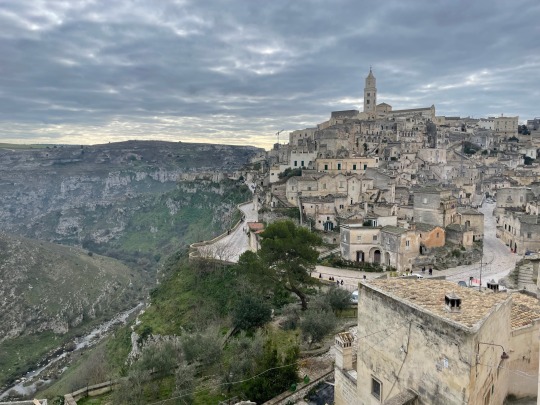
A Sojourn in Italia - Days 64 & 65 - Matera
Luisa has blogged about our drive through Alberobello and how we decided to give up and drive directly to Matera. On our way there, we were desperate to find a bar for both a toilet and for some lunch. Somehow the quiet country roads we were traversing did not have much to choose from. For example, following one sign to a pizzeria on a side road simply led us to a closed restaurant. We finally found a small bar open at about 1:30 and tried to order a couple of panini. The woman serving us apologised profusely but said that they were out of the small rolls that are used to make them and the only bread she had available was some sliced white bread (I didn’t think it even existed here!). I don’t think she expected us to accept the offer, but as Luisa said “quando si ha fame si deve mangiare ciò che è disponibile” (when you’re hungry you have to eat what’s available). The woman made us some toasted sandwiches with Mozzarella and Prosciutto. They were surprisingly good, the white bread letting the filling dominate. But what’s funny about this is while we sat eating our sandwiches, three other Italians individually refused the same offer preferring to go elsewhere. (see, sliced white bread really isn’t a thing here!)
Matera on the other hand was so good we decided to stay for an extra night. If some of the images look somewhat familiar, then you have probably watched one of several dozen movies that used Matera as their location. Perhaps two of the better known ones are the remake of Ben Hur. (2016) and the James Bond movie, No Time To Die.
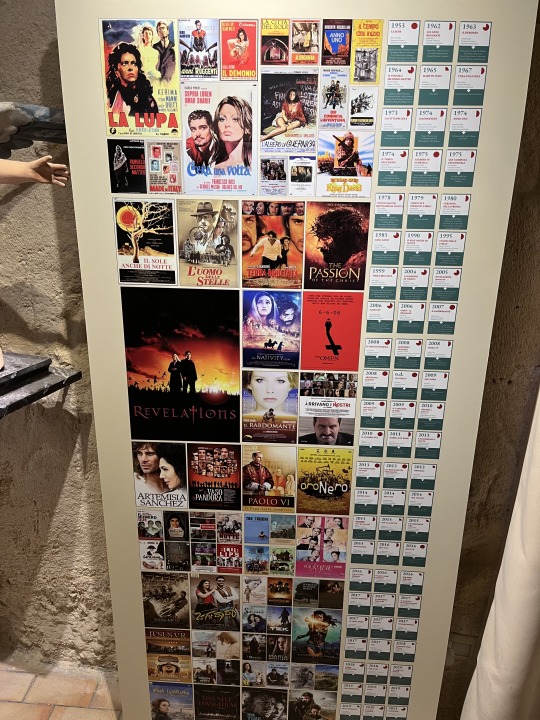
The original settlement of Matera lies in two canyons carved out by the Gravina River. This area, the Sassi di Matera, is a complex of cave dwellings carved into the walls of the ancient river canyon. Over the course of its history, Matera has been occupied by Romans, Longobards, Byzantines, Saracens, Swabians, Angevins, Aragonese, and Bourbons.

Matera is a World Heritage listed site and is most certainly picturesque, but its history is complicated. Lonely planet says that it’s perhaps the third-longest continuously inhabited human settlement, having first been settled in the paleolithic era, about 9,000 BC. It’s almost certainly the first inhabited area in Italy. As well as having abundant game in those times, the natural caves in the gorge are an attraction with the soft rock making it easy to both expand the existing caves and to create additional ones. The gorge is full of caves as are the lower sections of the main city. But in the mid 20th century, these caves were also a symbol of the poverty of Southern Italy. The region fell into poverty from the mid 1800s. In 1950, the Italian Prime Minister Alcide de Gaspari visited the area and was shocked, calling it the “shame of Italy”. He set about building new housing and forcibly moving the people out of the caves into the new homes. Only in 1962 were people allowed to reuse the caves and only if they fully restored and renovated them at their own expense. The main restoration of the area really began in the 1980’s with money from the EU, UNESCO and Hollywood!
Matera wasn’t always so poor, its had periods of splendour including during Roman times as a city either on or close to the famous Appian Way (I haven’t been able to quite clarify whether Matera was on the Appian Way or close to it, but either way it was an important Roman City). While the region was in deep poverty following WW2, its history is rich and the Sassi originally had good dwellings.
We arrived in Matera about 2:30 on Saturday afternoon and booked into our hotel. We’d deliberately chosen a modern hotel both for comfort and to keep costs low and because we did not want yet another AirBnB - some had not lived up to expectations. Our hotel was about 1.4 Km from the old city and an easy walk (no hills!). So we checked in, dumped our luggage in our room and headed off to the old city. We walked for about 1km towards what we thought was the centre of town, quite confused about the busy street which was quite contemporary, and what we’d read about the timelessness and very old age of Matera. We finally found a bar where we could stop, get ourselves an apperativo and check the maps we’d picked up at the hotel. Reassured the we were on the right track, we headed off up the road
We didn’t quite know what to expect but discovered that the Mercatino di Natale (Christmas market) was surprisingly still operating and that the place was full of people including many Italian’s who had decided to make use of the long-weekend. As the Friday was a festival day and a Public Holiday (the day of the Befana), this was a long weekend in Italy (they are rarer than in Australia as the Italians do not change public holidays to create long weekends and if the day falls on a weekend, then there’s no week-day catchup.)
As we wandered through the market, we came to the end of the road and a balcony where we could look over the the "Sassi di Matera" (the ‘Stones of Matera). It was an amazing sight - a crazy network of old, old buildings and narrow, cobbled streets. The Sassi were first settled in prehistoric times, and these dwellings are thought to be among the first ever human settlements in what is now Italy. So, of course, we set off down the stairs to explore the Sassi further. We wandered down into the heart of the tourist route through the Sassi, finally making our way up to the Duomo on the other side (the Duomo is the main church in any Italian city). The duomo was closed, so we stood with a crowd of people looking back towards the west watching the sun set.
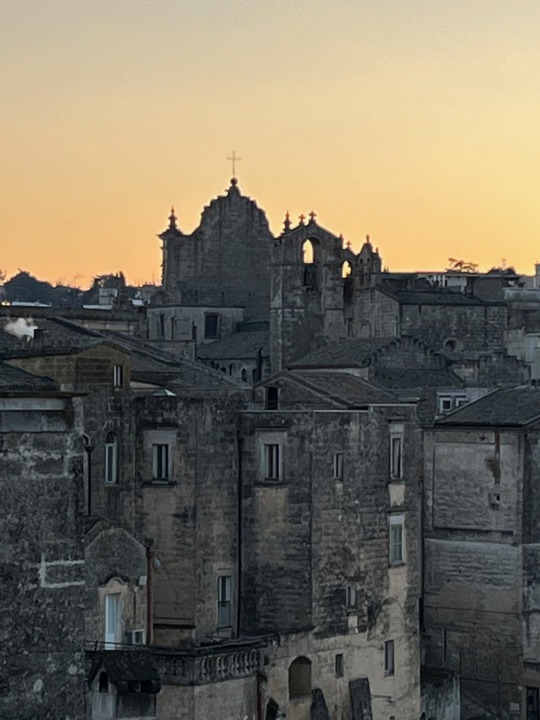
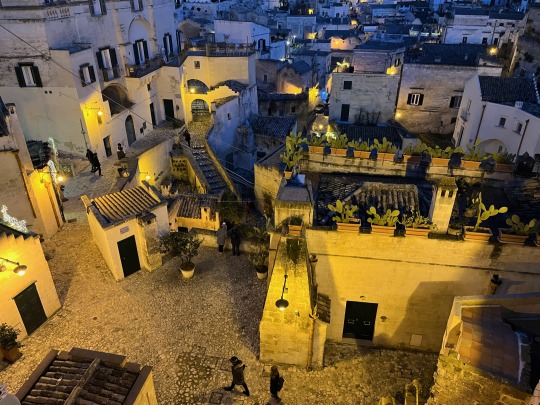
Some of the highlights of that first day:
We stumbled on the Chiesa di San Vitto al Lombardo, an old rock church that had been built in the 13th century (there are dozen of churches here in Matera which were built in the caves hundreds of years ago).
As we made our way to the Duomo, we heard the wonderful bells of its bell tower on the way. The Duomo is located in the Sasso Barisano area and habitation of this area in the high Middle Ages. The Duomo itself was built in the 1200’s, reaching completion in 1270.
We visited one of the old cave dwellings on our first day. The guide at this cave was able to give us a little information but we didn’t really get a sense of what living there might have been like.
We walked quite slowly (very rare for Luisa) because the rocky streets and stair were so slippery. I slipped on one occasion losing my footing despite wearing my Merrell boots which usually grip well. We both started slipping on numerous occasions as the paths are so worn that they are shiny. Luisa kept wondering about how many bones have been broken on these streets over the centuries.
Another church we stumbled across was the Chiesa San Giovanni Battista, a lovely old church, built in the 13th and 18th centuries. We spent some time in the church, listening to two musicians practicing on the organ and sax. It was peaceful, lovely and an appreciated break from all our walking.
After the sun set we decided to head back to our hotel and hopefully find somewhere to eat along the way. We were having no luck on our route until we passed by a panificio (bakery) specialising in sour dough. The has been operating since 1890 and is currently run by the great grand daughters of the original baker. We feasted on beautiful sour dough focaccia topped with artichokes and mushrooms, and a prosciutto and cheese strudel. The panificio was Il Forno di Gennaro.
Day 2:
The next morning after a satisfying breakfast at the hotel we set off to explore various parts of the city. Expecting to follow one route, we found ourselves going our own way to join the route we’d originally planned for the second part of the day, at its other end. Mainly we walked a route around the edge of the town, but we also revisited parts of the centre.
Some standouts in no particular order:
We visited another cave dwelling. This one was different to that of the first day being set up with a video and laid out like an original family dwelling. The video was a description of the life of a man who had lived in the cave as a young boy, his recollections of his life and homage to his father. The dwelling was set up with all the furniture and models of animals that the people who lived there would have raised. While it looked clean and fresh, the reality for the family which resided there would have been very different: the whole family lived and slept in the one room, with one bed for the parents and the eldest child. The other room had a single bed for another child and the baby slept in either a small crib or sometimes in the drawers of the old dresser. The second room (with the single bed) was for the animals which lived right there with the family - chickens which ran around the house, the donkey and a couple of pigs.
From the late 1800’s families in these cave houses lived in absolute poverty. As noted before, the government stepped in in the 1950’s and moved them to more modern accommodation. It’s hard to imagine what that process would have been like; to be taken away from everything that was familiar including the local community and probably their animals but to have access to a healthier and larger living space.
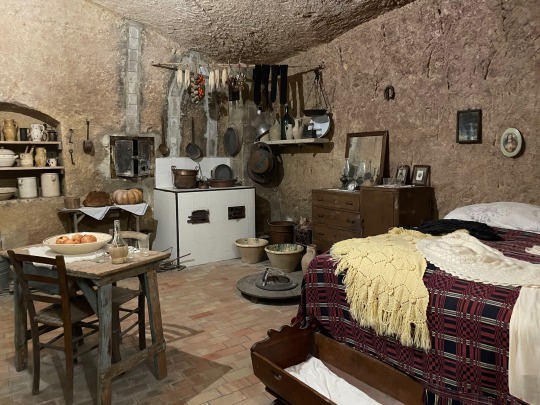

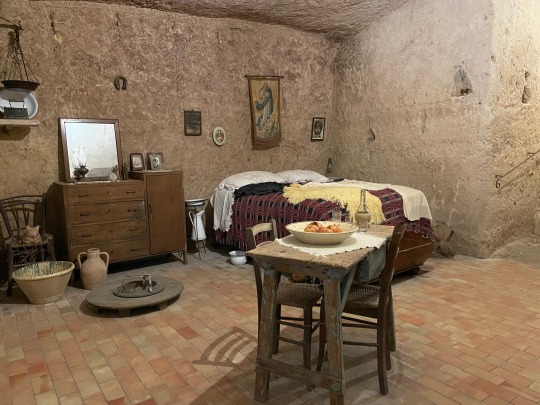

This article from the Guardian in 2017 gives some more information about these forced moves and how the Sassi have been revived - largely at the behest of a group of children who remembered the community values of the Sassi as well as the poverty and fought to have them restored. See:
To our surprise we came across several Dali statues during our walks. These were unexpected and a delightful surprise. As far as I can tell, the Dali exhibition in Matera was set up as part of it’s role as a European Capital of Culture and I think the exhibition was meant to be shown in early 2020. Of course Covid shut all that down and it seems that the exhibition has been held over to 2022. It’s destined to finish at the end of January 2023, but I suspect that the major works that have been set up in the piazza’s may be destined to remain they sure look permanent.
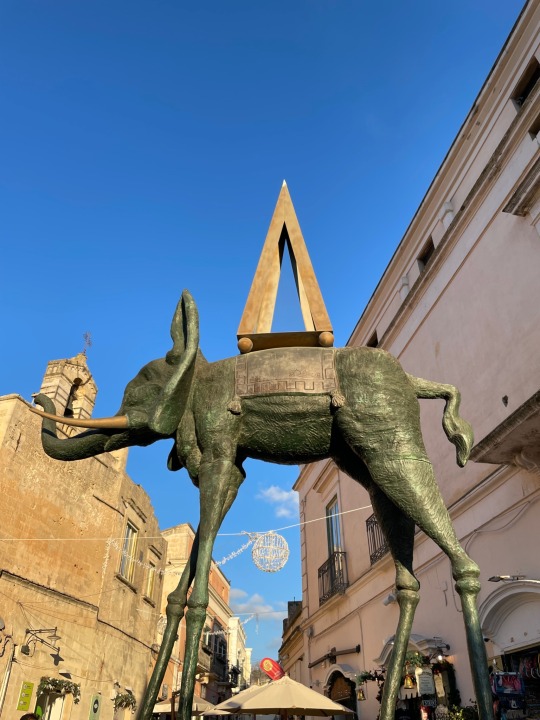
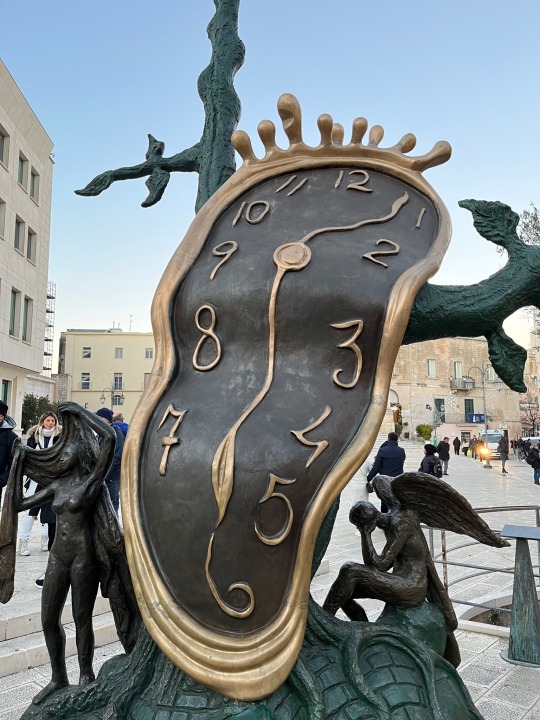
Another surprising find was a gallery of Nisio Lopergolo. As we walked through the Sassi, I noticed a couple of wooden carvings in a side street and we wandered up to have a look. Signore Nisio Lopergolo invited us into his gallery which is within one of the original cave dwellings. Nisio is a ceramic artist and sculptor and his work is very different to many of the other workshops/shops around Matera. He is an artist and he has received awards for his work. The pieces were stunning and also fascinating, and he took the time to explain some of the pieces to us.
One such piece which Nisio showed us was the Coppa di Pitagora (Pythagorean cup) or Justice cup. This cup is reputed to have been invented by the Greek philosopher and mathematician, Pythagoras, who wanted to convey a message of fairness to his countrymen, urging them to not be greedy but to be fair and balanced. The cup can be filled up t a certain point marked inside, but if it is filled beyond this point, all of the liquid is expelled completely through a hole at the bottom. As they say, “Grasp all, lose all”. Another design was a wine decanter that delivered a precise amount each time you pour out from it.

Nisio has carved figures into the walls and ceilings of his cave - you can see some of the figures on his website.
Later we made our way to the edge of Sasso Barisano, Civita, Rione Pianelle and Sasso Caveoso. We could see the caves on the other side of the canyon, and the paths leading down to the bottom of the canyon and over to the other side. Luisa was briefly tempted to walk the winding track down and over to the other side but it was only a very fleeting thought (we were both pretty tired by then).
Finally it was time to find a restaurant for lunch. But what we had forgotten was this was domenica (Sunday) and it seems that most Italians go out for Sunday lunch and booking a table is mandatory to secure a place. After unsuccessfully trying several restaurants including some rather pricy options, we finally settled on an unassuming bar/cafe, mainly because it was the only bar/cafe we found that advertised meals other than taglieri (platters of salumi and cheeses). Well weren't we in for a treat! My dish was a fantastic dish of Italian sausage cooked with carrots and cabbage in a paper wrap. While perhaps sounding unassuming it was wonderful. Luisa on the other hand, tried the baccala. Baccala is a dish made from dried salted cod and is not a traditional Puglian dish. But Luisa loves baccala and was interested in trying this variation on the traditional Venetian dish. It was delicious, with the cod being cooked lightly in a tomato based sauce (traditionally it's a cream or milk based sauce). We also tried out a dish of ceci neri cooked with wild chicory (delicious).
After lunch we walked up to the castello. Unfortunatlety it was closed and the path was very slippery. As you might expect the moat is empty but Luisa says she’d love to see a castle with a full moat!!!
We were better prepared for dinner that night. We’d bought a couple of bread rolls in the morning and we ate them for dinner - with a Puglian smoked cheese called caciocavallo, mixed lettuce and the last of our biscuits. And the chocolate we’d bought at the Mercatino di Natale which had been ridiculously overpriced and was actually pretty ordinary.
The next morning we headed back home via the autostrada. An interesting experience was at the payment gate on our exit. The machine could not read our entrance ticket (you grab a ticket from the gate on entering and autostrada and the exit gate reads this and works out your fee). We’d only noticed that the gate was broken after we’d driven in - it looked like someone had given up and driven through, so I don’t think our 's was the only ticket it couldn’t read. Anyway, you must not exit the vehicle and you must not try to back up. Help is via an intercom and in Italian. In my broken Italian I managed to explain that it could not read our ticket and eventually worked out that I was being asked to tell the man at the other end what the entrance location printed on the ticket was. He quickly entered the price manually from his terminal somewhere in the ether, the machine that couldn’t read our ticket read the credit card just fine and with the clear mechanical “Arrivederci” telling us it was fine to go we exited the gate.
2 notes
·
View notes
Text
Multicolor Italian design brutalist wall light by Longobard
A Brutalist single wall Light wrought iron structure with multicolored glass components. Italian design by Longobard. 1970s
#furniture#moderndesignfurniture#vintagefurniturecollections#thefmgallery#vintagefurniture#20thcenturylighting
0 notes